slide 2
Introduction Theoretical part Practical part Conclusion References Appendix
slide 3
Relevance of the research topic:
expanding the horizons of students about the knowledge of the world around them, in particular the starry sky.
slide 4
The object of the study is the constellation Ursa Major. The subject of the study is the development of quiz data about the constellation The hypothesis of the study - the information collected will help to recognize the constellation in the starry sky, to know the history of the constellation.
slide 5
Purpose of work:
Conduct a quiz in the 2nd "in" class on the topic "Constellation Ursa Major". Develop the cognitive and intellectual abilities of students.
slide 6
Tasks:
1. Collection of information from literary sources and the Internet; 2. To form the concept of "constellation" among students; 3. To introduce the history of the emergence of the constellation "Ursa Major"; 4. Conducting a quiz in the 2nd "in" class on the topic "Constellation Ursa Major".
Slide 7
Research methods:
Collection of information from literary sources and the Internet; - Analysis of the collected information; - Conducting a quiz in 2 "in" class.
Slide 8
Theoretical part.
Ursa Major is the third largest constellation (after Hydra and Virgo), seven bright stars which form the famous Big Dipper.
Slide 9
Slide 10
100,000 years ago our time 100,000 years later
slide 11
slide 12
slide 13
Slide 14
By the bucket you can determine the time. In the evening there is a lot of “water” in the Bucket, if half of the water “poured out” - it’s close to midnight, by morning there is almost no “water” left in the Bucket.
slide 15
slide 16
The constellation Ursa Major is depicted on the flag of Alaska.
Eight gold (yellow) five-pointed stars are depicted on a blue background: seven in the image of the Big Dipper and the North Star in the upper right corner. The Big Dipper symbolizes power, and the North Star - the north (Alaska is the northernmost territory of the United States).
Slide 17
Practical part.
We held a quiz in the 2nd "in" class on the topic "Constellation Ursa Major". The quiz was attended by 30 students.
Slide 18
After the work, we compiled a table:
Slide 19
Questions for the quiz:
1. What is the name of the Big Dipper in the common people? A) a cup, B) a ladle, C) a jar. 2. Ursa Major is ... A) a constellation, B) a star, C) a planet. 3. Where is the constellation in the area? A) first, B) third, C) second. 4. How many stars does the constellation consist of? A) 3, B) 9, C) 7. 5. Which hemisphere constellation is Ursa Major? A) north, B) south, C) west. 6. At what time of the year are the best visibility conditions for Ursa Major? A) autumn B) spring C) winter 7. Draw the Big Dipper.
Looking up, on cloudless nights it is easy to find a large bucket of the Big Dipper, but the problem of how to find the Little Dipper turns out to be unsolvable for many: its stars are rather dim, and the bright light street lamps and advertising structures, interior lighting of residential premises and other light sources that are turned on at night in the city interfere with the natural light environment of nature.
The night sky is poorly visible through the city illumination, so it is best to enjoy the beauty of the stars on open space where neither buildings nor artificial lighting interfere.
On a full moon, even the light of the moon can interfere, interrupting the modest stars of the desired constellation with its brightness. The ideal place and time for looking at the stars in the sky would be a moonless night in the steppe in a place located in the northern hemisphere of our planet.
Although the constellation Ursa Minor is small and its components are not too bright, its location in the sky near the north celestial pole is remarkable. It consists of 25 stars, large enough to be seen on a clear moonless night without aids.
Its configuration includes the North Star, which is almost exactly located at the north pole of the world and therefore convenient for orientation along the cardinal points. Due to the slow shift of the earth's axis, the situation will change over time and another star will indicate the northern direction, but in the next 1200 years, Ursa Minor can be safely used as a guide by finding the tip of the handle of her ladle.
Despite the 25 stars in this constellation, they recognize it by the seven largest of them, forming a memorable figure in the sky, similar to a ladle, at the end of the handle of which is the polar star. He is visible on Russian territory all year round and is one of the figures that serve as excellent reference points for the initial study of the starry sky.
Small Bucket Search Landmarks
 To understand how to find Ursa Minor, you need:
To understand how to find Ursa Minor, you need:
- know what the desired configuration looks like;
- understand that the composition of the small bucket includes only 3 more or less bright stars, and therefore a certain skill is needed;
- know the landmarks next to which the necessary stars are located in the sky.
The easiest way to start your search is with the brightest star in the constellation Ursa Minor - Polaris.
The reference point here will be the bucket of the Big Dipper. Finding it is not difficult even for a beginner.
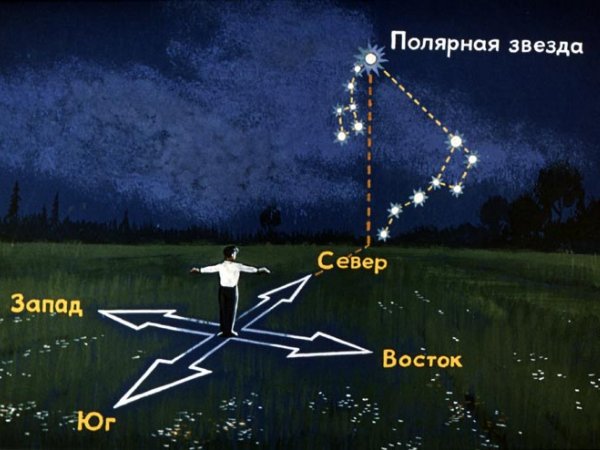 And then it all depends on the eye:
And then it all depends on the eye:
- Find a big bucket: in winter and autumn it descends to the horizon in the north, in summer they look for it in the west, where it hangs with its handle up, and in spring it is found in the east standing vertically with its handle down.
- Through the 2 extreme stars that form the side wall of the dipper (a and ß Ursa Major), mentally draw a line and extend it upwards in relation to the bowl of the dipper.
- Mentally put aside on this line 5 times the distance between a and ß, taken as a basis.
- In the area calculated in the sky, find a star of approximately the same brightness. This will be Polar, marking the end of the handle of the Ursa Minor bucket. The small bucket itself will stretch towards the Big Dipper, but its handle will bend in the opposite direction.
In the conditions of an urban sky illuminated by extraneous light sources, it is easy to find only three bucket stars, one of which is Polar.
The chance to detect the rest is much less, and sometimes due to excessive ambient illumination, they are not visible at all. Therefore, without sufficient experience, it is difficult to immediately recognize the desired group of stars. But after several trainings, the search will take place without difficulty, especially since the handle of the ladle is attached like a nail in the sky by the North Star to the point around which it, as if on a leash, rotates.
City dwellers have stopped looking at the starry sky, which is hard to see due to the lighting of the streets and surrounding high-rise buildings. But looking at the star dome calms thoughts and emotions.
Focusing on the search for Ursa Minor, you can turn away from the hustle and bustle of the work week and think about the beauty of other worlds located so far away that the light from them has not yet reached our planet.
August is famous for its rich, as if studded with diamonds, starry sky. This weekend, while kayaking along the Snigirevka River, spending the night at the bend of the river on a high cape, to the sounds of a jew's harp and a tambourine, I took several pictures of the starry sky. Successfully turned out the constellation Ursa Major, which I will talk about today.
Here is one of the pictures - in the window of the foliage of a nearby tree and the tops of pines on the opposite bank of the river, the bucket of the constellation just fit.
If it is difficult for anyone to identify it at first sight, in the next picture I specially marked the contours of the constellation with lines.
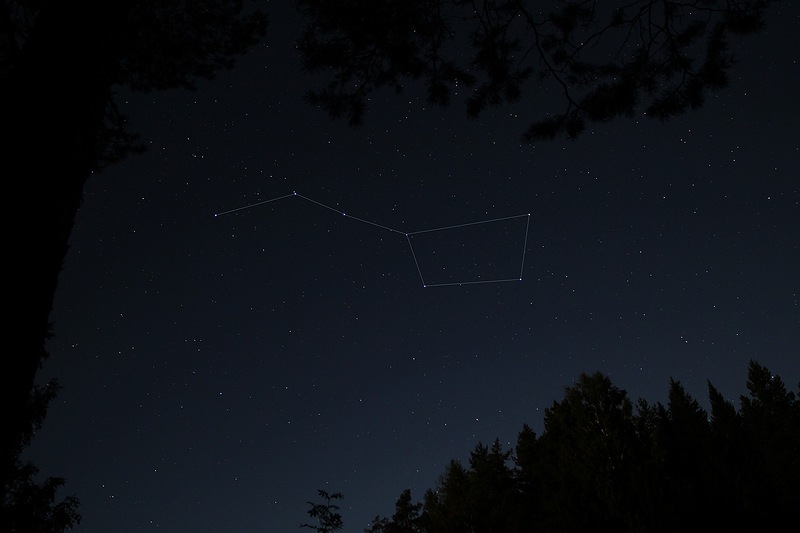
And there is beauty in the sky! The horizon is barely noticeably illuminated by the setting sun, the entire sky is strewn with sparkling diamonds of stars, the tops of the trees are slightly silvered by the almost full moon hiding behind the forest.
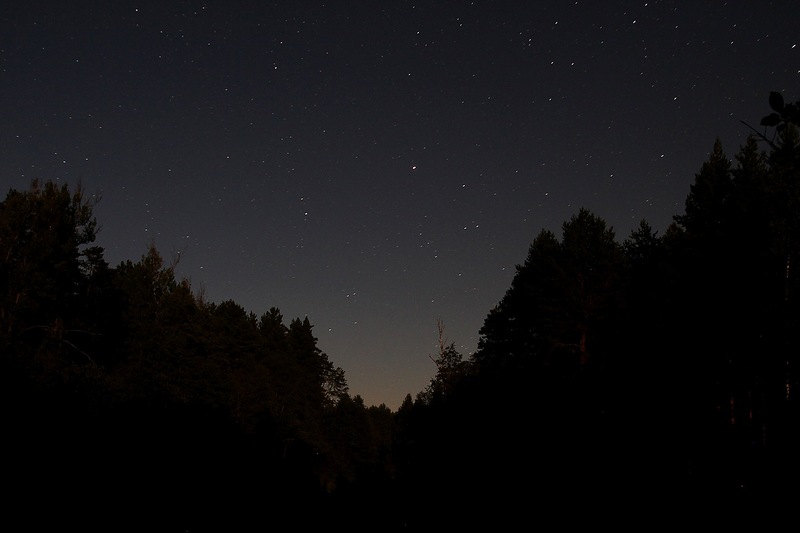
The fire is burning down, illuminating the red paws of the spruce, next to which we made a halt on the top of a high cliff near the bend of the Snigirevka River. The hypnotic-charming sounds of a harp and a tambourine made of natural leather, dried over a fire flame, are carried away into a deserted void.
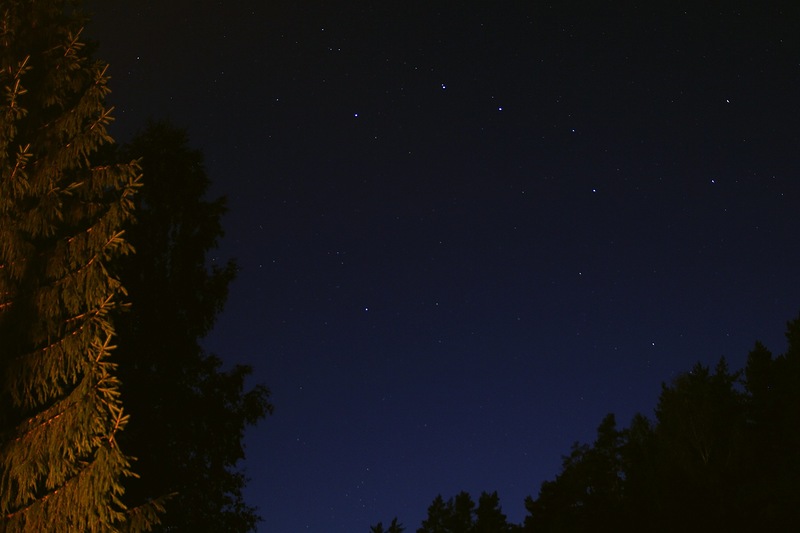
Nearby, a few steps along the absolute darkness among the pines, through the branches of which the needle rays of the moon carefully break through, there is a lake. It is absolutely round in shape, covered on all sides by forest, and round leaves of egg-pods float along the shore. Sometimes there is a faint splash of either a frog jumping into the water, or a mermaid luring a careless traveler. And in the grass, shy fireflies burn with green swamp lights, extinguishing their flame at any rustle or reflection of a flashlight. And if you turn off the flashlights and stand in complete darkness, the surrounding reality is completely transformed. The tops of the trees are illuminated with all kinds of silvery shades of moonlight, the water reflects the diamond dust of the star placer, everything around looks magical and crystal silver.

On this lyrical digression, perhaps, we will finish, and we will return to our constellation. It has been known since ancient times, although different peoples called differently. IN Ancient Russia it was the Elk, among other peoples the Plow, the Wagon, the Seven Wise Men, etc. Greek myth tells that the beautiful nymph Callisto was turned into a bear by Zeus to save her from the revenge of Hera. In Chinese astronomy, the seven bucket stars are called the Northern Dipper (Beidou). In ancient times, the ladle handle pointed almost to the pole and was used by the Chinese to keep time. Latin name constellation Ursa Major - Ursa Major. The constellation appears on some flags: on the flag of Alaska along with the Polar Star, the Irish Radical Organizations (IRA), the old flag of the White Sea Karelia.

The stars that make up the bucket are marked here. Traditionally, they are called the letters of the Greek alphabet, starting with the brightest star in descending brightness. Although in Ursa Major this rule fails - epsilon is brighter than alpha in it. In addition, each of the bucket stars has its own name. Like most stars, they are of Arab origin (the culture of the Arabs served as a bridge across the intellectual gulf separating the fall of Rome from the Renaissance). Let's look at each of the stars in more detail.
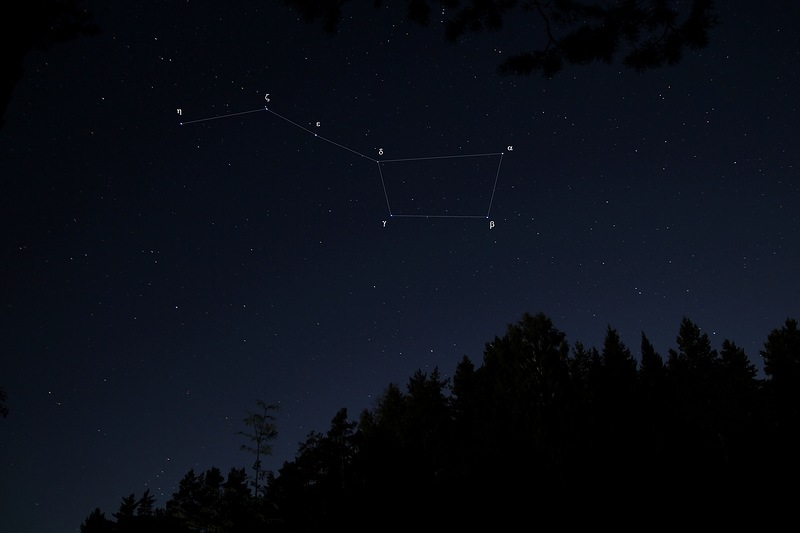
α (alpha) - Dubhe means "bear" in Arabic. The name comes from the Arabic ahr ad-dubb al-akbar - "the back of a big bear".
β (beta) - Merak- "lower back". In its star system, it shines 69 times brighter than the sun.
With the help of these two stars, you can find the North Star, which points to the north. To do this, through two stars (Dubhe and Merak) of the “wall” of the bucket, opposite to the “handle”, mentally draw a line on which to put off five times the distance between these extreme stars. At about the end of this line is the North Star. The direction to the North Star coincides with the direction to the north, and its height above the horizon coincides with the latitude of the observer.
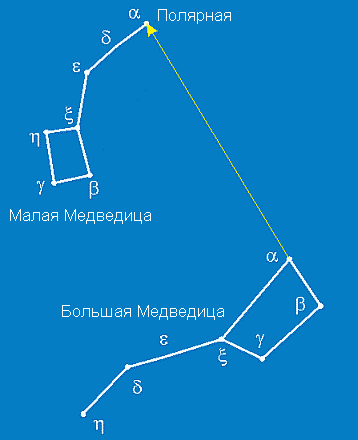
γ (gamma) - Fekda- "hip".
δ (delta) - Megrets- "root" (the beginning of the tail). The dimmest of the bucket stars, apparent magnitude +3.32. It is located 81 light years from us, about one and a half times larger and heavier than the sun, while it is 14 times brighter.
ε (epsilon) - Aliot- the brightest star in the constellation, by 0.05 magnitudes surpasses Dubhe. By right, it should be the alpha, but it happened historically. It is located on the 33rd place in brightness among all the stars in the visible part of the sky. Historically, this star has been used in maritime navigation.
ζ (zeta) - Mizar- "sash" or "loincloth". People with good eyesight see another star next to Mizar, called Alcor. The ability to see Alcor - traditional way vision checks. This couple is also called "Horse and Rider" and is the most famous double system stars. The full size images on this page also show both stars.
There is also a legend that allegedly in ancient egypt young men who could distinguish these stars were recruited into the elite troops of the pharaoh. This was proof that the vision was sharp enough. Versions of the legend feature Greek archers or Indian hunters. There is no confirmation of the reality of these facts. In addition, Mizar and Alcor are easily distinguishable as separate stars, even with average visual acuity.
η (this) - Benetnash or Alkaid from the full Arabic name al-qaeed banat ours, which means "leader of the mourners." This poetic image is taken from the Arab folk interpretation of the constellation Ursa Major (Hearse and Weepers). The constellation is represented by a funeral procession: in front of the mourners, led by the leader, behind them are the funeral stretchers.
It is the third brightest star in the constellation and the 35th brightest star in the sky. Benetnash is located at a distance of about 100 light years from the Sun. With a surface temperature of 22,000°K, it is one of the hottest stars that can be seen with the naked eye.
This is where I will end the astronomical digression, read the report on kayaking along the Snigirevka River, during which these pictures were taken. (the link is not working yet, the report is being added)








